the Creative Commons Attribution 4.0 License.
the Creative Commons Attribution 4.0 License.
The potential for using video games to teach geoscience: learning about the geology and geomorphology of Hokkaido (Japan) from playing Pokémon Legends: Arceus
Lewis J. Alcott
In recent years, video games, as a geoscience communication tool, have gained momentum. Popular commercial video games see millions of people around the world immersed in wondrous landscapes, many filled with real geological features including volcanoes, mineral deposits, and dinosaurs. Even though these features can be overlooked by many players as simple video game tropes, if utilized in educational environments or scientific outreach events, video games have the potential to encourage and stimulate teaching of geoscientific concepts, both in the classroom or in their own time. Here, we focus on the geo-educational potential of Pokémon Legends: Arceus, the latest game in the popular Pocket-Monster franchise, Pokémon. Pokémon Legends: Arceus is set in a fictional landscape, Hisui, that is directly based on the real-world island of Hokkaido, northern Japan. Both formal (peer-reviewed literature) and informal (online websites) resources are used to explore in-game and real-world geological feature comparisons and assess the game's educational potential. This paper demonstrates that a single commercial video game can be used to explore a variety of geological and geomorphological concepts including volcanology, economic geology, and hazard mitigation, with direct real-world examples to support the geoscientific understanding. Applications for this study could be extremely useful, not only for increasing interest and facilitating the self-learning of geoscience worldwide, but also for teaching in educational environments. From an educational standpoint, Pokémon Legends: Arceus could be used as a powerful tool to help students engage more in their learning by utilizing their natural affinity to the popular game and showcasing the many geological and geomorphological features found across the landscape of Hisui.
- Article
(15971 KB) - Full-text XML
- BibTeX
- EndNote
1.1 Learning via video games
Video games are commonly used to teach primary subjects for younger audiences (e.g. basic arithmetic and simple logic-based skills); however, video games have also previously been explored in various advanced educational topics for several years (Adams, 1998; Squire, 2005; Lenhart et al., 2008; Squire et al., 2008; de Freitas, 2008). In many cases, specifically designed games were developed to teach players about particular topics, focussing the gameplay on presenting players with information required to pass tasks and progress within the game (Shute et al., 2013; Mani et al., 2016; Kerlow et al., 2020). However, the teaching potential of such “educational” or “serious” games may be nullified by failing to hold players' attention through sufficiently engaging gameplay (Kerawalla and Crook, 2005; Van Eck, 2006; Floyd and Portnow, 2008). “Commercial” or “entertainment” video games on the other hand prioritize engaging and entertaining gameplay over educational learning. This may lead players to miss the educational potential by creating the perception of fictional content (Floyd and Portnow, 2008; Brown et al., 2014). As a result, the prioritization of entertainment over educational value is a deterrent for those wishing to use video games as educational tools.
The lines between educational- and entertainment-focused gaming are increasingly blurred as real-world events and locations more frequently form the basis of new games (Brown et al., 2014). Video games provide exposure and greater appreciation of base subject matter, with players exploring the real-world implications of the gaming subject (Brown et al., 2014). Because commercial video games capture the voluntary and undivided attention of millions immersed in rich landscapes for extended hours (Mayo, 2009), they are a logical tool for boosting geoscience communication and education efforts.
Video games can be used to achieve educational goals via four different means: (1) using game mechanics to teach specific skills, such as map reading; (2) expanding vocabulary with game narratives; (3) improving social skills such as teamwork and communication; and (4) promoting tangential learning, i.e. self-directed learning inspired by exposure to a topic one already enjoys (Floyd and Portnow, 2008; Turkay and Adinolf, 2012). This study examines only the affective realms of 1, 2, and 4, as area 3 belongs to the realm of multiplayer or forum-based games, which Pokémon Legends: Arceus is not a part of.
Recent work by Hut et al. (2019), McGowan and Scarlett (2021), and Clements et al. (2022) illustrates how popular commercial games (including Legend of Zelda: Breath of the Wild and Minecraft) could be used as a form of geoscience communication to promote and educate the wider public, covering topics such as volcanology and palaeontology. If effectively used, commercial video games can become a powerful tool in educational settings and at outreach events, to stimulate geoscientific education and engagement in students. However, despite the previously mentioned work, both on the use of video games in education in general and those directly applied to geoscience, video games are currently a rare resource tool used to teach geological concepts (Jolley et al., 2022).
Video games also have further benefits to those with learning difficulties (for example, attention deficit hyperactive disorders, ADD/ADHD, or dyslexia), who struggle to maintain focus using more conventional educational methods (Griffiths, 2002; Marino and Beecher, 2010; García-Redondo et al., 2019). In most cases, studies have shown video games improve a student's measured attention, as tested using the d2 test measures of attention and motivation towards formal learning (García-Redondo et al., 2019). Additional benefits also include improved language comprehension and mathematics skills (Franceschini et al., 2013), mental agility, strategic reasoning (García-Redondo et al., 2019), time management, and planning and organization (Bul et al., 2016).
1.2 Background of Pokémon Legends: Arceus
Released worldwide on 28 January 2022, Pokémon Legends: Arceus is part of the eighth generation of Pokémon games spanning over a 25-year period. The game was extremely popular, selling over 6.5 million copies worldwide during the first week of release, making it the fastest selling game of the franchise at the time of writing (Knezevic, 2022).
Each series of video games in the Pokémon franchise is set in a unique region, which is based on a real-world location. This not only inspires the design of the explorable game map (including layout, geography, and environments), but also the Pokémon (based on real and mythological animals associated with that region), clothing, culture, food, and architecture. The first four generations are set in fictional versions of Japan, while later generations are based on other countries and states, including New York, United States (Pokémon Black/White), and the United Kingdom (Pokémon Sword/Shield; O'Farrell, 2018). The fictional region of Hisui in Pokémon Legends: Arceus is directly based on the island of Hokkaido, Japan (The Pokémon Company International, 2022a). Hokkaido is used as inspiration for the Pokémon Diamond and Pearl games which are set during modern day, meaning that Pokémon Legends: Arceus is set in the past of the same region (Wikipedia, 2022).
Part of Pokémon Legends: Arceus' popularity lies in the game's graphics, which provides some of the most modern and realistic visuals seen in the franchise to date. Additionally, the gameplay has dramatically shifted from a fixed formulaic style with set paths for players to follow to providing several open-world biomes for players to freely explore to research the Pokémon in their natural habitats.
Pokémon Legends: Arceus' combination of improved three-dimensional graphics and real-world inspiration makes it an excellent choice to explore the educational potential of video games on geographic and geological features. It is important to note that even though much of the player base is likely to be classified as non-geoscientists, players are still likely to be able to identify differences between fake and realistic landscapes to inform their learning (Hut et al., 2019).
By comparing real-world and in-game features, this paper aims to explore and test if a single video game can be used for a variety of educational topics. By doing so, the apparent “realness” of the features can be assessed. This paper intends to be used as an example – in addition to the other “geo-gaming” literature – to highlight how commercial video games could be applied in an educational setting (facilitated learning) and encourage the player's own self-learning (tangential learning; Floyd and Portnow, 2008; Brown et al., 2014) of geoscientific topics (e.g. McGowan and Scarlett, 2021; Clements et al., 2022).
Authors identified geological and geomorphological features, including active volcanoes, crater lakes, and peninsulas, which were tied to key moments within the game's main narrative. This approach is inspired by McGowan and Scarlett (2021), where geoscientific features are identified in popular commercial video games and then compared to real-world examples. Features and areas that are a necessity for progression, therefore guaranteeing player interaction, are particularly addressed. Features encompass extremely visible landmarks, including volcanoes, or frequently referred to locations that contain geological context in their name.
Real-world counterparts of the in-game features were identified based on geographical location and physical characteristics. Comparisons between the literature content and in-game appearance were made to determine if they form suitable explanations for the inspiration behind each feature.
It should be noted that Pokémon Legends: Arceus was developed to be played by the general population and not specifically for academic specialists. Therefore, informal sources (for example, Wikipedia and online magazines) will also be used alongside peer-reviewed literature as players potentially prefer this type of resource (Nisbet and Scheufele, 2009) or may be unable to access scientific papers behind paywalls.
When comparing the in-game map of Hisui and that of Hokkaido, Japan, including topographic and geological maps (Ayalew et al., 2011), striking similarities in the topography and coastal outline are seen (Fig. 1). Therefore, players can identify locations within Pokémon Legends: Arceus based on their relative geographic location and similarities (e.g. volcanic craters identifiable in topographic maps), and the literature reviews can provide additional geological understanding of the features (Table 1).
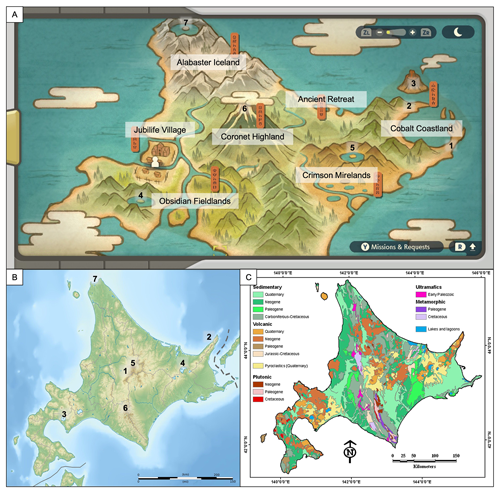
Figure 1Topographic maps of Hisui, Pokémon Legends: Arceus, and Hokkaido, Japan. (a) Annotated in-game map of Hisui from Pokémon Legends: Arceus. Note the non-traditional angle of viewing and artistic style. (1) Deadwood Haunt, (2) Veilstone Cape, (3) Firespit Island, (4) Lake Verity, (5) Lake Valor, (6) Mt Coronet, (7) Lake Acuity © The Pokémon Company International (2022a). (b) Terrain map of Hokkaido, Japan (1) Biei Blue Pond, (2) Shiretoko Peninsula, (3) Lake Tōya, (4) Lake Kussharo, (5) Mt Asahi, (6) Hidaka Mountains, (7) Lake Onuma (Bourrichon, 2019). (c) Geological map of Hokkaido, Japan (Ayalew et al., 2011).
Table 1Summary of author interpretations of the geological and geomorphological features selected within Pokémon Legends: Arceus, based on in-game visuals or prompts, versus the geological understanding of the features post-literature review.
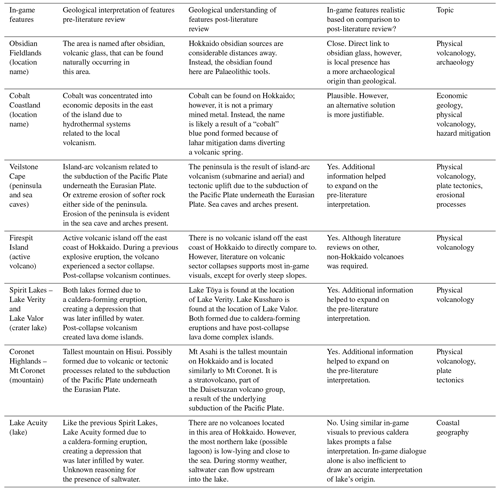
3.1 Obsidian Fieldlands
The first open area players may explore is the Obsidian Fieldlands: a lush grass land, with hilly ground in the centre, a large, forked river cutting northeast to southwest, and a dense forest in the south. The locality's name suggests obsidian naturally occurs on this part of the island.
Indeed, obsidian is a common volcanic material found on Hokkaido, having at least 21 confirmed primary sources of the glass across the island (Izuho and Sato, 2007). In contrast to Hisui however, the majority of sites are located in the northeast of Hokkaido, around the Kitami Mountains, over 100 km from the Ishikari Lowland (Fig. 2a; Izuho and Sato, 2007; Akai, 2008) – where the Obsidian Fieldlands are paralleled in Pokémon Legends: Arceus (Figs. 1 and 2b).
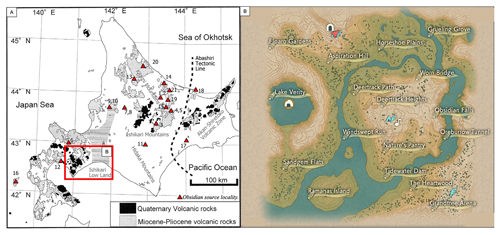
Figure 2(a) Map of Hokkaido showing the source locations of all 21 recorded obsidian sites (red triangles) across the island (Izuho and Sato, 2007) and the location of the Ishikari Lowland that the Obsidian Fieldlands (red box) is based on in Pokémon Legends: Arceus. (b) A zoomed-in game map of the Obsidian Fieldlands (zoomed-out version in Fig. 1a) from Pokémon Legends: Arceus © The Pokémon Company International (2022a).
The obsidian of Hokkaido was an important resource to Palaeolithic inhabitants on the island, where it was shaped into microblade tools. Such tools were created between 26 and 10 ka (Akai, 2008; Yakushige and Sato, 2014) and were widely transported across the island, including the Ishikari Lowland and Honshu, Japan's main island (Yakushige and Sato, 2014). X-ray fluorescence analysis of the obsidian microblades from the Ishikari Lowland allows individual tools to be traced back to their primary origin, including Akaigawa, ∼40 km to the west, and Shirataki, over 170 km northeast (Akai, 2008).
An additional homage to Hokkaido obsidian is in the newly released Pokémon, “Kleavor”. It can be obtained using “black augurite” (a fictional mineral) or caught in the wild. Despite black augurite being fictional, its item design and Kleavor's mirror obsidian. Furthermore, the official description of Kleavor states Hisuians used the chipped pieces of stone that fell off Kleavor as tools (The Pokémon Company International, 2022b), evoking the use of obsidian tools by Hokkaido's indigenous inhabitants.
Whilst the name, Obsidian Fieldlands, suggests obsidian would be naturally present in this region, this is false. Instead, obsidian was likely transported from elsewhere on the island, suggesting the name is more of a homage to the once important resource to the Palaeolithic inhabitants.
3.1.1 Cobalt Coastlands
The Cobalt Coastlands, found on the east coast of Hisui, is another open-access area (Fig. 1a). As with the Obsidian Fieldlands, one could expect cobalt to be found in this coastal region. However, cobalt is mined in the central regions of Hokkaido, not on the east coast (Khoeurn et al., 2019). This draws into question the use of “cobalt” in the area's name. Is it purely a catchy use of alliteration, or is there greater geological influence?
The area's name could be related to the popular tourist destination known as the Blue Pond (Fig. 1b), a human-made pond famous for its “cobalt” blue waters (Biei Tourist Association, 2017; Smart Magazine, 2018). Following the 1988 eruption of Tokachi-Dake volcano, concrete dams were built to divert volcanic mudflows (lahars) away from populated areas (Ministry of Land, Infrastructure, Transport and Tourism, 2016; Smart Magazine, 2018). Lahars are amongst the deadliest volcanic hazards, ranking third (primary lahars) and fourth (secondary lahars) out of 13, based on the total number of fatalities (Brown et al., 2017). Not only can they flow tens to hundreds of kilometres from the flanks of a volcano, but secondary lahars can occur years after the primary event (Brown et al., 2017). An unexpected result of the hazard mitigation was that aluminium-rich spring water from the volcano was also diverted, leading to formation of a pond with a distinctively blue hue (Smart Magazine, 2018).
While the Blue Pond is in central Hokkaido, not near the east coast where the Cobalt Coastlands are in Pokémon Legends: Arceus, a number of larch trees were drowned by the pond, turning silvery white as they died (Smart Magazine, 2018). Such trees are found within the southern part of the Cobalt Coastlands in the area named Deadwood Haunt (Fig. 1a), which contains numerous ghost-type Pokémon, possibly a tribute to the drowned trees of the Blue Pond (Fig. 3). This adds further merit to the idea that the Cobalt Coastlands are based upon the popular tourist destination.
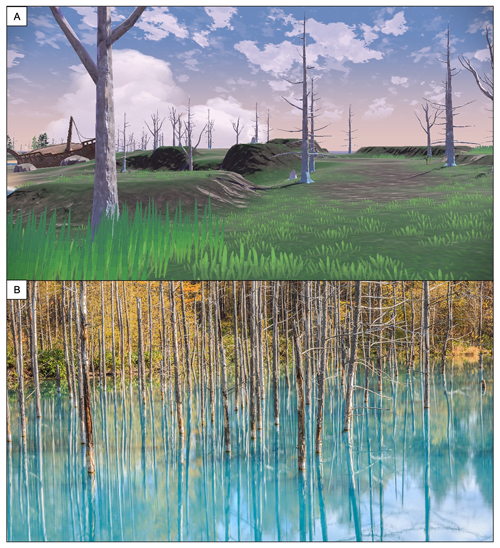
Figure 3Comparison image of in-game and real-world inspiration. (a) White trees found in Deadwood Haunt, Cobalt Coastlands, in Pokémon Legends: Arceus (Fig. 1a1), © The Pokémon Company International (2022a). (b) Photograph of dead larch trees, Blue Pond, central Hokkaido (Fig. 1b1) (Gilad Rom, 2015).
3.1.2 Veilstone Cape – volcanic chains, arches, and caves
One of the most prominent geomorphic features in the Cobalt Coastlands is the Veilstone Cape, a tall, narrow rocky headland (Fig. 1a). On Hokkaido, the comparable feature is known as the Shiretoko Peninsula (Fig. 1b). The real-world peninsula is the result of several overlapping volcanic complexes (Neogene to Holocene in age) that form the Kuril volcanic chain, running NEE–SWW from central Hokkaido to the eastern end of Shiretoko Peninsula (Minato et al., 1972). The volcanic chain constitutes part of the Kuril Islands arc system – a 1175 km arc system produced by the subduction of the Pacific Plate along the Kuril Trench (Khomich et al., 2018) – and through submarine volcanism, uplift, and continued terrestrial volcanism resulted in the steep topography along the Shiretoko Peninsula (Chakraborty, 2018).
Along the Veilstone Cape in Pokémon Legends: Arceus, caves and arches cut through the coastal cliff (Fig. 4a). While the comparable erosional features in Hokkaido are not as well reported as other elements mentioned in this paper, the cause may be due to the Shiretoko Peninsula being much wider and less steep than the in-game Veilstone Cape. As the fictional cape (Fig. 4a) is taller and narrower than its real-world counterpart, it would be easier for coastal erosion to create the prominent arches seen at the end of the peninsula. Travelling inland, the arches decrease in size, eventually forming only sea caves, where the coastal waters have yet to erode through and connect both sides, cleverly demonstrating the progressive evolution and formation of natural sea arches (BBC, 2022; Fig. 4b).
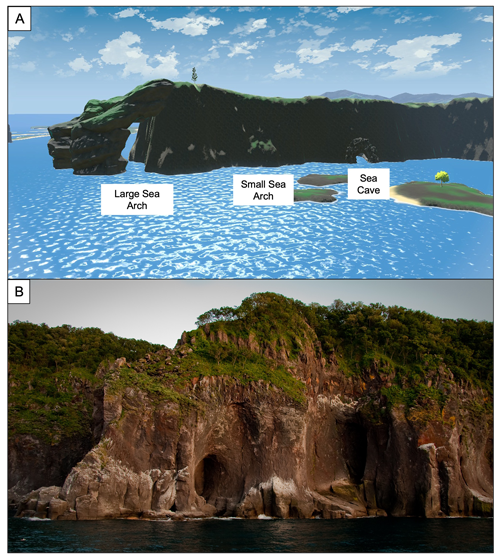
Figure 4(a) Sea arches and sea caves that can be found along Veilstone Cape in Cobalt Coastlands, Pokémon Legends: Arceus (Fig. 1a2), © The Pokémon Company International (2022a). (b) Photograph of coastal arches found along the Shiretoko Coast (Fig. 1b2) (civ33, 2009).
The major inaccuracy of Veilstone Cape is the size of the headland. In the real world, the Shiretoko Peninsula is much longer and wider and has a gentler profile. However, this is likely a calculated resizing by developers to ensure the headland remains visually impressive without making it feel like a chore for players to traverse, something for which games with large maps can receive bad reviews for (Tassi, 2018).
3.1.3 Firespit Island – active volcano
Off the coast of the Cobalt Coastlands, in the northeast of the region, is Firespit Island (Figs. 1a and 5a). This is a fictional location without a real-world equivalent in Hokkaido. Firespit Island is a large volcanic edifice, likely to be a stratovolcano due to its steep, conical slopes and tectonic setting and this being the most common type of video game volcano (McGowan and Scarlett, 2021). It has a distinguishable crater rim that is taller in the east, presumably the product of a violent explosive eruption that destroyed the rest of the cone (Fig. 5a). To the west is a gap in the outer slopes and a shallow fan reaching into the sea. These pieces of evidence suggest a sector collapse and/or lateral blast modified the morphology of the main edifice and produced a debris avalanche (Romero et al., 2021).
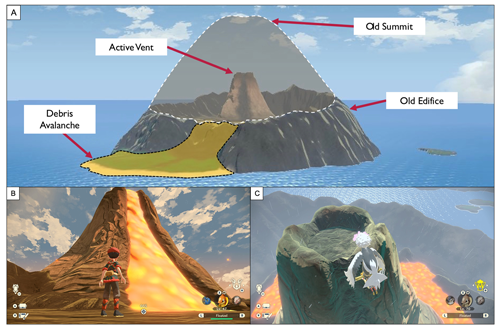
Figure 5Images of the volcano, Firespit Island, located in the Cobalt Coastlands in Pokémon Legends: Arceus (Fig. 1a3) (a) Annotated schematic of Firespit Island showing a hypothetical look of the volcano pre-sector collapse and highlighting the resulting debris avalanche. (b) Close-up of the steep, central active vent with lava flowing out. (c) Volcanic plug that forms after the lava eruption ceases. © The Pokémon Company International (2022a). There is no direct comparison for this volcano found on Hokkaido, Japan (Fig. 1b).
Lava pours out of the vent of a new volcanic cone within the centre of the collapsed edifice (Fig. 5b), which is one of the most common volcanic attributes seen in video games (McGowan and Scarlett, 2021). Post-collapse volcanism is common in volcanoes around the world, including Anak Krakatoa (Indonesia), Mt St Helens (United States), Soufrière Hills (Montserrat), and Bezymianny (Russia) (Girina, 2013; Watt et al., 2012; Watt, 2019). However, lava produced in these post-collapse craters is typically highly viscous and does not “pour out” of the vents (Carr et al., 2022). After progressing further through the storyline of the game, the lava ceases and solidifies into a mass within the vent, forming a plug (Fig. 5c).
Even though it is typical for mafic stratovolcanoes in arc settings, like that of Hokkaido, to rapidly build themselves upwards, producing steep slopes, typically between 21 and 40∘ (Romero et al., 2021), the old edifice and central vent on Firespit Island exceed this, producing an unrealistically steep slope and cone (Fig. 5). This is another common trope of video game volcanoes, with other overly steep stratovolcanoes also seen in Legend of Zelda: Breath of the Wild and Monster Hunter: Generations Ultimate (McGowan and Scarlett, 2021).
3.2 Spirit Lakes – flooded calderas
The storyline takes players to three lakes found across Hisui (Fig. 1a). Upon reaching the islands in the centre of Lake Verity in the Obsidian Fieldlands (Fig. 6a) and Lake Valor in the Crimson Mirelands (Fig. 6c), a character named Volo explains that many believe these lakes formed after volcanoes erupted and craters later filled; the geographical locations of the two Hisuian lakes suggest they are the in-game versions of Lake Tōya (Fig. 6b) and Lake Kussharo (Fig. 6d) respectively.
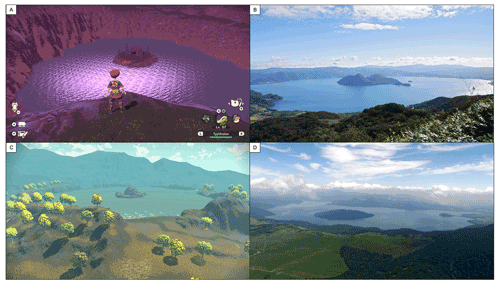
Figure 6Comparison image of in-game and real-world inspiration. (a) Lake Verity, Obsidian Fieldlands, with caldera rim and lava dome island in Pokémon Legends: Arceus (Fig. 1a4) © The Pokémon Company International (2022a). (b) Photograph of Lake Tōya, Hokkaido, with Nakajima Island, Japan (Fig. 1b3) (633highland, 2013a). (c) Lake Valor, Crimson Mirelands, with caldera rim and lava dome island in Pokémon Legends: Arceus (Fig. 1a5) © The Pokémon Company International (2022a). (d) Photograph of Lake Kussharo, Hokkaido, with Nakajima Island, Japan (Fig. 1b4) (633highland, 2013b).
The description of Lake Verity's formation (in the game) mirrors the series of six continuous rhyolitic caldera-forming eruptions which produced Lake Tōya and the <80 m thick Tōya Ignimbrite around 110 ka (Fig. 6b). The first five events were phreatomagmatic, suggesting the presence of a pre-caldera lake (Machida et al., 1987; Goto et al., 2018). Post-caldera volcanism (around 40–45 ka) produced Nakajima, an andesitic to dacitic dome complex in the centre of the lake (Goto et al., 2018).
Lake Kussharo (Lake Valor equivalent) is also situated within Kussharo Caldera (Fig. 6d). The last major caldera-forming eruption is estimated around 30 ka (Fujiwara et al., 2017). Like Tōya Caldera, a post-caldera dome complex formed, producing a dacitic to rhyolitic island (Global Volcanism Program, 2013a), alongside an additional caldera complex, the Atosanupuri Caldera, within the eastern half of Kussharo Caldera during the Holocene (Fujiwara et al., 2017).
In both scenarios, the geomorphology of the Spirit Lakes and the descriptive dialogue in Pokémon Legends: Arceus accurately portray features of real-world caldera lakes and post-caldera lava domes on Hokkaido.
3.3 Coronet Highlands – volcanic peaks
The centre of Hisui houses a large mountainous area known as the Coronet Highlands, where the tallest mountain on the island, Mount Coronet is located (Fig. 1a). It can be presumed that the real-world equivalent is Mount Asahi, a 2291 m stratovolcano within the Daisetsuzan mountain range, part of the Daisetsuzan volcano group, a complex of numerous stratovolcanoes and lava domes (Global Volcanism Program, 2013b).
The Coronet Highlands are a barrier of progress in the modern-day setting of Pokémon Diamond, Pearl, and Platinum and likely represent the roughly north–south-trending Hidaka Mountains on Hokkaido (Fig. 1b). The Hidaka Mountains were initially formed through the collision of Eurasia and North American plate boundaries approximately 13 Ma within the Hidaka collision zone (Ichihara et al., 2019).
The Coronet Highlands also contain a “special magnetic field” that allows for the evolution of certain Pokémon, such as Nosepass. Lodestones, a rare form of magnetite (Mills, 2004), are thought to be driven by lightning remanent magnetization, allowing them to be found at the Earth's surface as opposed to at depth (Wasilewski and Kletetschka, 1999), and were previously used in compasses. They are therefore a likely inspiration for Nosepass, which is noted to always point north and is checked by travellers to get their bearings (Bulbapedia, 2022).
3.4 Lake Acuity – lagoon
Lake Acuity is the third Spirit Lake found within Hisui (Figs. 1a and 7a). Unlike the two previously mentioned flooded caldera Spirit Lakes (Sect. 3.5), Volo does not say this lake formed due to a volcanic eruption. Instead, the character states it contains seawater but does not know whether this is related to its geography or a Pokémon. This hints at a different origin for Lake Acuity.
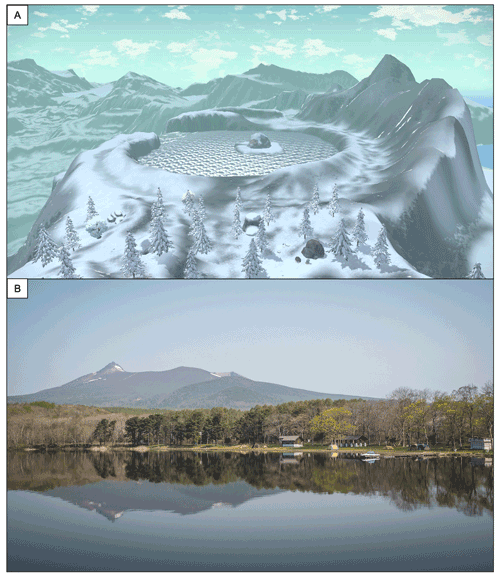
Figure 7Comparison image of in-game and real-world inspiration. (a) Lake Acuity, Alabaster Iceland, a high-seat, crater-like lake with a central island in Pokémon Legends: Arceus (Fig. 1a7) © The Pokémon Company International (2022a). (b) Photograph of Lake Onuma, Hokkaido (Fig. 1b7). Lake Onuma does not have a central island (Thompson, 2015).
The origin of Lake Acuity is difficult to determine from in-game visuals alone because it is similar to the previously mentioned lakes (a topographically circular lake with an island in the middle), so it could be assumed it is also a flooded caldera with a central lava dome complex (Figs. 6a, c and 7a). However, when consulting a geological map (Fig. 1c), no volcanic features are found in the real-world region, supporting the hint that Lake Acuity did not form in the same way as the other two Spirit Lakes and instead has a non-volcanic origin.
The lake is the most northern in Hisui and therefore can be assumed that its real-world equivalent is Lake Onuma, Wakkanai (Fig. 7b), the most northern lake in Hokkaido (Fig. 1b). Due to Lake Onuma's proximity to the ocean at Soya Bay, tidal inflows can bring seawater into the lake (Ministry of the Environment, 2015). Despite none of the literature directly stating the lake's origin, it is more akin to a coastal lagoon than a volcanic lake and explains the change of descriptive dialogue.
4.1 Tangential learning about Hokkaido
Pokémon Legends: Arceus utilizes a wide range of resources to communicate geological features to the player, including maps, physical structures/graphics, and dialogue from characters. These details may be used to facilitate learning and stimulate curiosity about the geology of Hokkaido. From the topics covered in this paper, Pokémon Legends: Arceus can be used to teach volcanology, hazard mitigation, economic geology, and more (Table 1). Whilst this knowledge was mostly applied to Hokkaido, the general principles could also be transferred to other similar geological settings around the world.
While not every topic covered was explored in detail, this is realistic of the expectations for a player to do online searches to quickly understand more about features they have seen in the game. At the same time, these seem to be sufficient to gain a basic understanding of this region's basic geology and geomorphology.
It is not logical to expect every player to share enough interest in geoscience-related topics to stimulate any desire for tangential learning. However, as noted by Floyd and Portnow (2008), even if only 0.1 % of players conducted online investigations into a single feature mentioned herein, Pokémon Legends: Arceus would have facilitated a modicum of geoscience learning for >6500 people worldwide.
Even in situations such as understanding the use of “cobalt” in the name of the Cobalt Coastlands, where the outcome was not as conclusive as others (e.g. the flooded caldera lakes with direct real-world equivalents), players are presented with the opportunity to learn about both mining on Hokkaido and lahar risk management, while critically analysing the in-game evidence to draw a conclusion.
There is also the possibility that the opportunity to learn about the real-world equivalents of game features could stimulate further interest to pursue additional tangential learning. For example, learning that Lake Verity and Lake Tōya formed due to a caldera-forming eruption, players could continue to research the volcanism of Hokkaido by investigating Firespit Island due to its very prominent volcanic features (crater, active vent, molten lava, etc.), or the similar-looking Lake Acuity and discover its non-volcanic origins. This could even expand into players conducting tangential learning on features not specifically found in the game, or on a larger scale (e.g. plate-tectonics and island-arc formation that resulted in the formation of Hokkaido).
Caution is warranted when using video games in educational settings as the potential for learning misinformation is high. For example, players are informed that two of the three caldera lakes formed via volcanic activity; however the third lake is suggested to be possibly formed through different, unmentioned means. A caldera lake is defined by the volcanic activity that led to its formation; however due to the lack of volcanic activity in northern Hokkaido, there is merit to the change in descriptive dialogue.
In addition, over-exaggeration is often found in popular media including video games to provide a more entertaining experience through “speculative fiction” and artistic liberty (Shaw, 2014; Politopoulos et al., 2019). Such evidence was found in Pokémon Legends: Arceus in the overly steep volcanic slopes on Firespit Island. Unrealistically steep volcanic slopes are a common over-exaggerated feature of video game volcanoes (McGowan and Scarlett, 2021). It is efforts such as those demonstrated here that allow for the apparent accuracy and authenticity of features found within a medium to be assessed and then utilized in educational settings, as opposed to simply assuming learning will take place regardless of the quality of representation.
Furthermore, tangential learning through commercial gameplay can also be conducted using other games. For example, numerous mineralogical items are considered resources in video games that can ultimately lead to players better understanding the real world. A case of this was presented by Robb (2013) when interpreting mineral deposits in Elder Scrolls V: Skyrim or the numerous games covered by Clements et al. (2022) on palaeontological topics.
4.2 Using video games in geosciences
Despite professional instructors rarely utilizing video games to teach geological concepts (Jolley et al., 2022), this example illustrates how they can be used to teach about a wide range of topics in an engaging way. Compared to other literature on the subject matter that investigates a single topic across numerous commercial video games (McGowan and Scarlett, 2021; Clements et al., 2022), the focus of this paper shows how one game can introduce several geoscientific topics and potentially spark additional interest. This should reassure geoscience educators that they do not require access to multiple different video games to provide sufficient examples for their course.
The shift to online-based and hybrid learning following the COVID-19 pandemic has led to increasing reliance on newly developed teaching methods including virtual field trips (MacKay, 2020; Bond et al., 2021) and other digital resources (Pringle et al., 2017; Jeffery et al., 2021). Video games can augment this new education paradigm. The use of virtual learning, including video games, holds numerous benefits, including increased accessibility for students who cannot attend field-based teaching due to costs or physical disabilities, as well as the ability to visit high-risk locations (Stainfield et al., 2000; Pringle et al., 2017).
The high standards of graphics, gameplay, and internal functions of commercial video games take considerable time and funding (Mayo, 2009) which educators cannot be expected to invest themselves. However, specific areas or features can require significant amount of gameplay to reach, meaning that alternatives should be investigated. YouTube or Twitch streams have access to thousands of video game walk-throughs, meaning one could select the appropriate video that covers the desired location or feature to show students in the classroom, without needing to own or play the game. The downside to this is reduced control over what is shown and no opportunity for students to directly engage in gameplay. Educators could also set homework to investigate the geology observed in a video game (either through direct gameplay or via videos), with further prompts and questions to help guide the students learning and promote tangential learning at home.
Pokémon Legends: Arceus also provides players with opportunities to develop other skills, for example, providing the player context to practise map-reading skills and exposure to the utility of topographical maps.
Pokémon Legends: Arceus could also prove to be useful for geoscience communication to the wider public at geoscience outreach events. The game has a generally relaxed gameplay style and quick-to-understand controller mechanics; therefore, the game could be offered to non-geoscientists at outreach events, allowing them to be casually under the tutelage of a geoscientist. Pokémon Legends: Arceus is also rated PEGI 7, meaning it is appropriate for everyone over the age of seven and so accessible to a wide range of people.
Pokémon Legends: Arceus includes a wide range of geological and geomorphological aspects within its design, drawing direct inspiration from features found on Hokkaido. This ability to directly compare virtual and real-world counterparts could stimulate tangential learning in players should they be curious enough. Whilst an entire curriculum cannot be covered using Pokémon Legends: Arceus, it offers an additional way of communicating the science found in numerous geoscientific topics to the player/student.
Though care must be taken, either through using resources such as this one or a prior demonstration of the game to ensure appropriate information is being taught. The exposure potential of geological and geomorphological concepts through video games could be widespread. If only a small fraction of the player base conducts such learning, because the game is so popular and sold millions of copies, Pokémon Legends: Arceus can potentially facilitate learning about Hokkaido's geoscience for thousands of players worldwide. This reach can be extended by using the game as a prompt in classrooms to increase student engagement.
Furthermore, the popularity of commercial video games within the wider public could be leveraged at outreach events to enhance general understanding of and engagement with regional geoscience topics. Specifically, Pokémon Legends: Arceus can be used to engage people with Hokkaido's geology in an entertaining way. In the proper context, a single popular commercial game has the potential to be a powerful tool for geoscience communication and education.
All data were collected through playing Pokémon Legends: Arceus on the Nintendo Switch. Additional background information about the game can be found at https://legends.pokemon.com/en-us/ (last access: 9 March 2022, The Pokémon Company International, 2022c). We do not have permission from the developers to share free access to the game. However, it is publicly accessible to purchase.
This research was conceptualized by EGM and LJA. The methodology, investigation, formal analysis, resources and data curation, original draft, and reviewer edits were completed by EGM and LJA. Visualization was produced by EGM.
The contact author has declared that none of the authors has any competing interests.
The work presented is original and reflects the authors' views. Ethics approval and informed consent were not sought; this study does not deal with sensitive data or human participants.
Publisher's note: Copernicus Publications remains neutral with regard to jurisdictional claims in published maps and institutional affiliations.
We would like to thank Marc Reichow for taking time out of his busy schedule to review this paper during the draft phases. Additionally, we acknowledge the funding from the NERC CENTA DTP and the Yale Institute for Biospheric Studies.
This project has not been funded directly. However, Edward G. McGowan has been funded by the NERC CENTA DTP studentship. Lewis J. Alcott has been funded by a Hutchinson Postdoctoral Fellowship from the Yale Institute for Biospheric Studies.
This paper was edited by Leslie Almberg and reviewed by Jazmin Scarlett and Jamie Pringle.
633highland: Lake Toya Toyako Hokkaido (photo), Wikimedia Commons, https://commons.wikimedia.org/w/index.php?curid=28499249 (last access: 8 March 2022), 2013a.
663highland: Lake Kussharo seen from the west, in Teshikaga, Hokkaido Prefecture, Japan, Wikimedia Commons, https://commons.wikimedia.org/w/index.php?curid=27737997 (last access: 25 June 2022), 2013b.
Adams, P. C.: Teaching and learning with SimCity 2000, J. Geogr., 97, 47–55, 1998.
Akai, F.: The Terminal Pleistocene Microblade Industry In Hokkaido (Japan): A Case Of The Southern Ishikari Lowland, Kunstkamera, https://kunstkamera.ru/files/lib/978-5-02-025271-4/978-5-02-025271-4_09.pdf (last access: 24 February 2022), 2008.
Ayalew, L., Kasahara, M., and Yamagishi, H.: The spatial correlation between earthquakes and landslides in Hokkaido (Japan), a GIS-based analysis of the past and the future, Landslides, 8, 433–448, https://doi.org/10.1007/s10346-011-0262-z, 2011.
BBC: Bitesize: Caves, arches, stacks and stumps, https://www.bbc.co.uk/bitesize/guides/zsfwcwx/revision/6, last access: 24 February 2022.
Biei Tourist Association: Shirogane Blue Pond, https://www.biei-hokkaido.jp/en/sightseeing/shirogane-blue-pond/ (last access: 4 March 2022), 2017.
Bond, C. E., Pugsley, J. H., Kedar, L., Ledingham, S. R., Skupinska, M. Z., Gluzinski, T. K., and Boath, M. L.: Learning outcomes, learning support and cohort cohesion on a virtual field trip: an analysis of student and staff perceptions, Geosci. Commun. Discuss. [preprint], https://doi.org/10.5194/gc-2021-36, in review, 2021.
Bourrichon: Hokkaidō géolocalisation relief 000 (image), Wikimedia Commons, https://commons.wikimedia.org/w/index.php?curid=27004129 (last access: 8 March 2022), 2019.
Brown, T., Li, H., Nguyen, A., Rivera, C., and Wu, A.: Development of Tangential Learning in Video Games, Department of CIS, University of Pennsylvania, PA, 2013–2014, https://nanopdf.com/download/development-of-tangential-learning-in-video-games_pdf (last access: 6 October 2022), 2014.
Brown, S. K., Jenkins, S. F., Sparks, S., Odbert, H., and Auker, M.: Volcanic fatalities database: analysis of volcanic threat with distance and victim classification, Journal of Applied Volcanology, 6, 15, https://doi.org/10.1186/s13617-017-0067-4, 2017.
Bul, K. C. M., Kato, P. M., Van der Oord, S., Danckaerts, M., Vreeke, L. J., Willems, A., van Oers, H. J. J., Van Den Heuvel, R., Birnie, D., Van Amelsvoort, T. A. M. J., Franken, I. H. A., and Maras, A.: Behavioral Outcome Effects of Serious Gaming as an Adjunct to Treatment for Children with Attention Deficit/Hyperactivity Discorder: A Randomized Controlled Trial, J. Med. Internet Res., 18, e26, https://doi.org/10.2196/jmir.5173, 2016.
Bulbapedia: Nosepass (Pokémon), https://bulbapedia.bulbagarden.net/wiki/Nosepass_(Pok%e9mon), last access: 7 March 2022.
Carr, B. B., Lev, E., Vanderkluysen, L., Moyer, D., Marliyani, G. I., and Clarke, A. B.: The Stability and Collapse of Lava Domes: Insight From Photogrammetry and Slope Stability Models Applied to Sinabung Volcano (Indonesia), Front. Earth Sci., 10, 813813, https://doi.org/10.3389/feart.2022.813813, 2022.
Chakraborty, A.: Shiretoko Peninsula: Dynamic Interaction Between Geology, Geomorphology, and Ecology at The Interface of Terrestrial and Marine Systems, in: Natural Heritage of Japan, edited by: Chakraborty A., Mokudai K., Cooper M., Watanabe M., and Chakraborty, S., Geoheritage, Geoparks and Geotourism, Springer, Cham, https://doi.org/10.1007/978-3-319-61896-8_4, 2018.
Civ33: Shiretoko Coast (photo), Flickr, https://www.flickr.com/photos/7591669@N03/4272562834 (last access: 8th March 2022), 2009.
Clements, T., Atterby, J., Cleary, T., Dearden, R., and Rossi, V.: The perception of palaeontology in commercial off-the-shelf video games and an assessment of their potential as educational tools, EGUsphere [preprint], https://doi.org/10.5194/egusphere-2022-84, 2022.
de Freitas, S.: Area Games Effective Learning Tools? A Review of Educational Games, Educ. Technol. Soc., 21, 74–84, https://www.jstor.org/stable/26388380, 2008.
Floyd, D. and Portnow, J.: Video Games and Learning, YouTube, http://www.youtube.com/watch?v=rN0qRKjfX3s (last access: 23 February 2022), 2008.
Franceschini, S., Gori, S., Ruffino, M., Viola, S., Molteni, M., and Facoetti, A.: Action video games make dyslexic children read better, Current Biology, 23, 462–466, https://doi.org/10.1016/j.cub.2013.01.044, 2013.
Fujiwara, S., Murakami, M., Nishimura, T., Tobita, M., Yarai, H., and Kobayashi, T.: Volcanic deformation of Atosanupuri volcanic complex in the Kussharo caldera, Japan, from 1993 to 2016 revealed by JERS-1, ALOS, and ALOS-2 radar interferometry, Earth Planets Space, 69, 78, https://doi.org/10.1186/s40623-017-0662-y, 2017.
García-Redondo, P., García, T., Areces, D., Núñex, J. C., and Rodríguez, C.: Serious games and their effect improving attention in students with learning disabilities, Int. J. Environ. Res. Pub. He., 16, 2480, https://doi.org/10.3390/ijerph16142480, 2019.
Goto, Y., Suzuki, K., Shinya, T., Yamauchi, A., Miyoshi, M., Danhara, T., and Tomiy, A.: Stratigraphy and Lithofacies of the Toya Ignimbrite in Southwestern Hokkaido, Japan: Insights into the Caldera-forming Eruption of Toya Caldera, Journal of Geography (Chigaku Zasshi), 127, 191–227, https://doi.org/10.5026/jgeography.127.191, 2018.
Gilad Rom: Blue Pond Biei (photo), Flickr, https://www.flickr.com/photos/9464116@N08/22444350445 (last access: 8th March 2022), 2015.
Girina, O. A.: Chronology of Bezymianny Volcano activity, 1956–2010, J. Volcanol. Geoth. Res., 263, 22–41, https://doi.org/10.1016/j.jvolgeores.2013.05.002, 2013.
Global Volcanism Program: Kussharo, Smithsonian Institution, https://volcano.si.edu/volcano.cfm?vn=285080 (last access: 24 February 2022), 2013a.
Global Volcanism Program: Taisetsuzan, Smithsonian Institution, https://volcano.si.edu/volcano.cfm?vn=285060 (last access: 25 February 2022), 2013b.
Griffiths, M.: The educational benefits of videogames, Education and Health, 20, 47–51, 2002.
Hut, R., Albers, C., Illingworth, S., and Skinner, C.: Taking a Breath of the Wild: are geoscientists more effective than non-geoscientists in determining whether video game world landscapes are realistic?, Geosci. Commun., 2, 117–124, https://doi.org/10.5194/gc-2-117-2019, 2019.
Ichihara, H., Mogi, T., Satoh, H., and Yamaya, Y.: Electrical resistivity modeling around the Hidaka collision zone, northern Japan: regional structural background of the 2018 Hokkaido Eastern Iburi earthquake (Mw 6.6), Earth Planets Space, 71, 100, https://doi.org/10.1186/s40623-019-1078-7, 2019.
Izuho, M. and Sato, H.: Archaeological obsidian studies in Hokkadio, Japan: Retrospect and prospects, Indo-Pacific Prehistory Association Bulletin, 27, 8 pp., 2007.
Jeffery, A. J., Rogers, S. L., Jeffery, K. L. A., and Hobson, L.: A flexible, open, and interactive digital platform to support online and blended experiential learning environments: Thinglink and thin sections, Geosci. Commun., 4, 95–110, https://doi.org/10.5194/gc-4-95-2021, 2021.
Jolley, A., Dohaney, J., and Kennedy, B.: Teaching about volcanoes: Practices, perceptions, and implications for professional development, Volcanica, 5, 11–32, https://doi.org/10.30909/vol.05.01.1132, 2022.
Kerawalla, L. and Crook, C.: From Promises to Practice: The Fate of Educational Software in the Home, Technol. Pedag. Educ., 14, 107–125, 2005.
Kerlow, I., Pedreros, G., and Albert, H.: Earth Girl Volcano: characterizing and conveying volcanic hazard complexity in an interactive casual game of disaster preparedness and response, Geosci. Commun., 3, 343–364, https://doi.org/10.5194/gc-3-343-2020, 2020.
Khoeurn, K., Sasaki, A., Tomiyama, S., and Igarashi, T.: Distribution of Zinc, Copper, and Iron in the Tailings Dam of an Abandoned Mine in Shimokawa, Hokkaido, Japan, Mine Water Environ., 38, 119–129, https://doi.org/10.1007/s10230-018-0566-5, 2019.
Khomich, V. G., Boriskina, N. G., and Kasatkin. S. A.: Geology, magmatism, metallogeny, and geodynamics of the South Kuril islands, Ore Geol. Rev., 105, 151–162, https://doi.org/10.1016/j.oregeorev.2018.12.015, 2018.
Knezevic, K.: Pokemon Legends: Arceus sets a new series sales record on Switch: cnet, https://www.cnet.com/tech/gaming/pokemon-legends-arceus-sets-a-new-series-sales-record- on-switch/, last access: 14 April 2022.
Lenhart, A., Kahne, J., Middaugh, E., Macgill A. R., Evans, C., and Vitak, J.: Teens, video games and civics: Teens' gaming experiences are diverse and include significant social interaction and civic engagement, Pew Research Centre, https://www.pewresearch.org/internet/2008/09/16/teens-video-games-and-civics/ (last access: 7 April 2022), 2008.
Machida, H., Arai, F., Miyauchi, T., and Okumura, K.: Toya Ash – A widespread Late Quaternary Time-Marker in Northern Japan, Quarternary Res., 26, 129–145, 1987.
MacKay, M.: Imperial geosciences complete UK's first MSc virtual field trip, Imperial College London, https://www.imperial.ac.uk/news/196961/imperial-geoscientists-complete-uks-first-msc/ (last access: 6 March 2022), 2020.
Mani, L., Cole, P. D., and Stewart, I.: Using video games for volcanic hazard education and communication: an assessment of the method and preliminary results, Nat. Hazards Earth Syst. Sci., 16, 1673–1689, https://doi.org/10.5194/nhess-16-1673-2016, 2016.
Marino, M. and Beecher, C.: Conceptualizing RTI in 21st-Century secondary science classrooms: Video games' potential to provide tiered support and progress monitoring for students with learning disabilities, Learning Disabilities, 33, 299–311, 2010.
Mayo, M. J.: Video Games: A Route to Large- Scale STEM Education?, Science, 323, 79–82, https://doi.org/10.1126/science.1166900, 2009.
McGowan, E. G. and Scarlett, J. P.: Volcanoes in video games: the portrayal of volcanoes in commercial off-the-shelf (COTS) video games and their learning potential, Geosci. Commun., 4, 11–31, https://doi.org/10.5194/gc-4-11-2021, 2021.
Mills, A.: The Lodestone: History, Physics, and Formation, Ann. Sci., 61, 273–319, https://doi.org/10.1080/00033790310001642812, 2004.
Minato, M., Hashimoto, S., Fujiwara, Y., Kumano, S., and Okada, S.: Stratigraphy of the Quaternary Ash and Pumiceous Products in Southwestern Hokkaido, N. Japan (The Pliocene and Quaternary Geology of Hokkaido, 1st Report), Journal of the Faculty of Science, Hokkaido University, 4, 679–736, 1972.
Ministry of Land, Infrastructure, Transport and Tourism (MLIT):  [Blue Pond Visitor Attraction in Biei Town], MLIT, Japan,
https://web.archive.org/web/20161002024552/http://www.as.hkd.mlit.go.jp/chisui04/tokachi_guide/pdf/aoiike.pdf (last access: 4 March 2022), 2016 (in Japanese).
[Blue Pond Visitor Attraction in Biei Town], MLIT, Japan,
https://web.archive.org/web/20161002024552/http://www.as.hkd.mlit.go.jp/chisui04/tokachi_guide/pdf/aoiike.pdf (last access: 4 March 2022), 2016 (in Japanese).
Ministry of the Environment: Kutcharo-ko, Ministry of the Environment Government of Japan https://web.archive.org/web/20150919105818/http:/www.env.go.jp/en/nature/npr/ramsar_wetland/pamph/ramsarpamphen/kutcharo.pdf (last access: 6 March 2022), 2015.
Nisbet, M. C. and Scheufele, D. A.: What's next for science communication? Promising directions and lingering distractions, Am. J. Bot., 96, 1767–1778, https://doi.org/10.3732/ajb.0900041, 2009.
O'Farrell, B.: How Pokémon's world was shaped by real-world locations, Polygon, https://www.polygon.com/2015/4/10/8339935/pokemon-locations-tokyo-new-york-unova-france-kalos-region, (last access: 9 April 2022), 2018.
Politopoulos, A., Mol, A., Boom, K., and Ariese, C.: “History Is Our Playground”: Action and Authenticity in Assassin's Creed: Odyssey Advances in Archaeological Practice, 7, 317–323, https://doi.org/10.1017/aap.2019.30, 2019.
Pringle, J. K., Bracegirdle, L., and Potter, J. A.: Educational Forensic E-gaming as Effective Learning Environments for Higher Education Students, Forensic Science Education and Training: A Tool-kit for Lecturers and Practitioner Trainers, 1st edn., John Wiley & Sons Ltd, United States, 119–136, https://doi.org/10.1002/9781118689196.ch9, 2017.
Robb, J.: The Geology of Skyrim: An unexpected Journey, EGU blogs, https://blogs.egu.eu/geolog/2013/11/15/the-geology-of-skyrim-an-unexpected-journey/ (last access: 4 March 2022), 2013.
Romero, J. E., Polacci, M., Watt, S., Kitamura, S., Tormey, D., Sielfeld, G., Arzilli, F., La Spina, G., Franco, L., Burton, M., and Polanco, E.: Volcanic Lateral Collapse Processes in Mafic Arc Edifices: A Review of Their Driving Processes, Types and Consequences, Front. Earth Sci., 9, 639825, https://doi.org/10.3389/feart.2021.639825, 2021
Shaw, A.: The Tyranny of Realism: Historical accuracy and politics of representation in Assassin's Creed III, Loading…, 9, 4–24, https://journals.sfu.ca/loading/index.php/loading/article/view/157 (last access: 28 July 2022), 2014.
Shute, V. J., Ventura, M., and Kim, Y. J.: Assessment and Learning of Qualitative Physics in Newton's Playground, J. Educ. Res., 106, 423–430, https://doi.org/10.1080/00220671.2013.832970, 2013.
Smart Magazine: Biei blue pond is a cobalt blue fantasy world that is worth visiting, J-Trip, https://magazine.japan-jtrip.com/article/hokkaido/7955/ (last access: 23 February 2022), 2018.
Squire, K.: Changing the game: What Happens When Video Games Enter the Classroom, Innovate: Journal of Online Education, 1, 1–7, https://nsuworks.nova.edu/innovate/vol1/iss6/5 (last access: 7 April 2022), 2005.
Squire, K., DeVane, B., and Durga, S.: Designing centres of expertise for academic learning through video games, Theor. Pract., 47, 240–251, 2008.
Stainfield, J., Fisher, P., Ford, B., and Solem, M.: International virtual field trips: a new direction?, J. Geogr. Higher Educ., 24, 255–262, https://doi.org/10.1080/713677387, 2000.
Tassi, P.: 'Assassin's Creed Odyssey' and when length counts against a game', Forbes, https://www.forbes.com/sites/insertcoin/2018/10/02/assassins- creed-odyssey-and-when-length-counts-against-a-game/?sh=1dbf046f55bb (last access: 1 April 2022), 2018.
The Pokémon Company International (TPCi): Pokémon Legends: Arceus, Standard Edition, Version 1.1, Nintendo Switch [Game], TPCi, Tokyo, Japan, https://www.nintendo.co.uk/Games/Nintendo-Switch-games/Pokemon-Legends-Arceus-1930510.html, last access: 16 July 2022a.
The Pokémon Company International (TPCi): Pokémon Legends: Kleavor, TPCi, https://legends.pokemon.com/en-us/pokemon/kleavor/, last access: 6 March 2022b.
The Pokémon Company International (TPCi): Pokémon Legends, TPCi, https://legends.pokemon.com/en-us/, last access: 9 March 2022c.
Thompson, R.: Overlooking the campground in Onuma Park, Hokkaido, Japan, Flickr, https://www.flickr.com/photos/14degrees/16766072474/, 2015.
Turkay, S. and Adinolf, S.: What Do Players (Think They) Learn in Games?, Procd. Soc. Behv., 46, 3345–3349, https://doi.org/10.1016/j.sbspro.2012.06.064, 2012
Van Eck, R.: Digital Game-Based Learning: It's Not Just the Digital Natives Who Are Restless, EDUCAUSE review, 41, 16–30, https://er.educause.edu/-/media/files/article-downloads/erm0620.pdf (last access: 18 April 2022), 2006.
Wasilewski, P. and Kletetschka, G.: Lodestone: Natures only permanent magnet-What it is and how it gets charged, Geophys. Res. Lett., 26, 2275–2278, https://doi.org/10.1029/1999GL900496, 1999.
Watt, S. F. L.: The evolution of volcanic systems following sector collapse, J. Volcanol. Geoth. Res., 384, 280–303, 2019.
Watt, S. F. L., Talling, P. J., Vardy. M. E., Masson, D. G., Henstock. T. J., Hühnerbach, V., Minshull, T. A., Urlaub, M., Lebas, E., Le Fraint, A., Berndt, C., Crutchley, G. J., and Karstens, J.: Widespread and progressive seafloor-sediment failure following volcanic debris avalanche emplacement: Landslide dunamics and timing offshore Montserrat, Lesser Antilles, Mar. Geol., 323–325, 69–94, 2012.
Wikipedia: Pokémon Diamond and Pearl: https://en.wikipedia.org/wiki/Pok%e9mon_Diamond_and_Pearl, last access: 19 August 2022.
Yakushige, M. and Sato, H.: Shirataki obsidian exploitation and circulation in prehistoric northern Japan, Journal of Lithic Studies, 1, 319–342, https://doi.org/10.2218/jls.v1i1.768, 2014.





